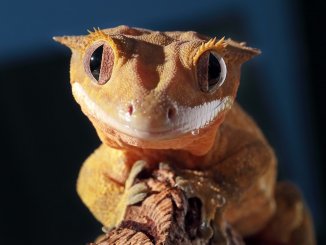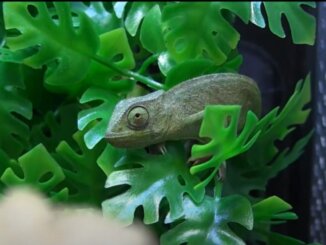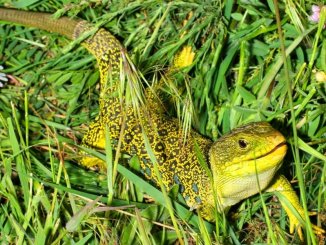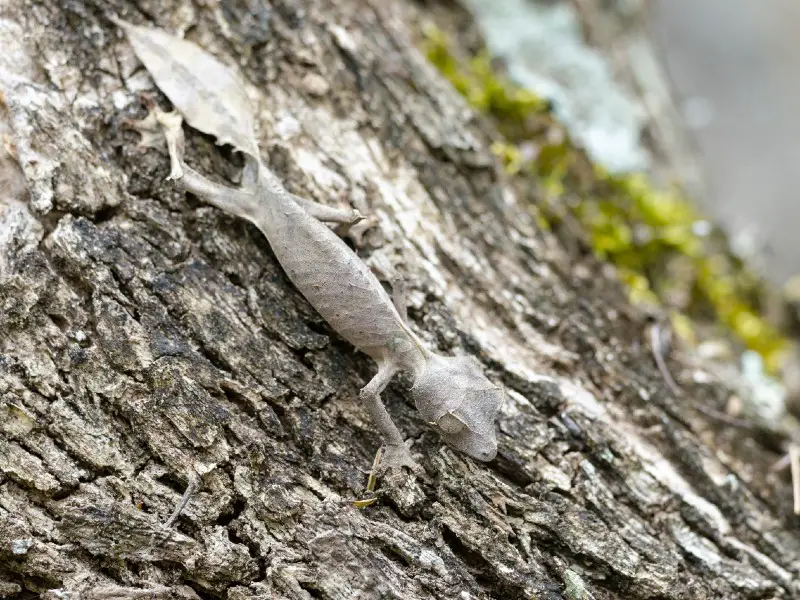
Satanic leaf-tailed geckos are not pets for the faint of heart. They require an expert’s care and attention but can be very rewarding and unique companions. Their temperament is very shy, and they do not like to be handled, but they will provide lots of entertainment with their radical climbing skills and outlandish appearance.
This guide will provide you with all you need to know to take care of your satanic leaf-tailed gecko. We will cover diet and feeding, lifespan and health concerns, behavior, safety, cost, tank setup, appearance, breeding, and more. Dive in to learn more about this wonderfully charismatic little reptile that could be your next pet!
Care Guide
Diet and Feeding
Satanic leaf-tailed geckos are hunters and meat-eaters; therefore, they should be supplied with roaches, flies, spiders, and crickets that are coated with a multivitamin or calcium supplement powder to ensure there are receiving all the necessary nutrients. If you are trying to breed your satanic leaf-tailed geckos, snails provide essential nutrients that will help ensure healthy babies.
Always be sure to check that the bugs provided for food are no bigger than the width of your gecko’s neck, or it could choke. Being active hunters, satanic leaf-tailed geckos prefer live prey over dead. Just be sure to check in their tank every couple of days and remove any food that has been in too long to avoid them getting sick.
Satanic leaf-tailed geckos do not need a water bowl. They will drink the droplets that accumulate on the various surfaces of their tank if you spray the tank with a light mist every day.
Lifespan and Health Concerns
As long as its nutritional and health needs are met, satanic leaf-tailed geckos can live up to ten years in captivity. It’s important to pay close attention to your gecko’s behavior and take them to the vet if you notice eye or nose discharge, lethargy, loss of appetite, or changes in skin color or appearance.
Satanic leaf-tailed geckos are susceptible to metabolic bone disease, which can be easily prevented if they receive daily vitamins like those with which you should dust their insect food. They can also contract parasites and mites if their tank is not kept clean so ensure regular cleanings and vet visits to test their waste.
Keep your gecko’s tank at a humidity level above 65%; otherwise, too dry conditions may lead to excessive shedding. Be aware that high humidity can also breed mold and mildew which is another reason why regular tank inspections and cleanings are so important.
To prevent mold from building up, causing your satanic leaf-tailed gecko to become sick, make sure there is proper ventilation in the tank. Ultraviolet lights can also help prevent mold from growing as it kills active spores and will not harm your gecko.
Signs that your gecko is dehydrated may include curling of the tail, so be sure to mist the tank every day. Satanic leaf-tailed geckos can have fragile dispositions, and too much handling or cold water misting can lead to a highly stressed-out pet, which can affect their appetite and overall health.
Behavior
As previously mentioned, satanic leaf-tailed geckos do not like to be handled and prefer to climb the walls of their tank or hide among the vegetation and decorations in their habitat. They move very slowly and blend in quite well with their surroundings as they are masters of camouflage.
They communicate either by moving their tails in specific ways for different purposes, such as aggression, stress, or willingness to mate. They also signal to other geckos vocally by barking or humming.
Since geckos do not have eyelids, a common behavior you may witness is your pet licking its own eyeballs to keep them moist and clean out any dirt or dust that may land on the lenses.
Satanic leaf-tailed geckos are nocturnal creatures, so do not be alarmed if you don’t witness a lot of activity or even feeding on your gecko during the day. Most of their prowling around will occur during the night.
How to Keep the Satanic Leaf Tailed Gecko Safe
The biggest concerns for the satanic leaf-tailed gecko’s safety are the control of its environment. They prefer high humidity, over 65%, but cooler temperatures than most other lizards. During the day, an ambient temperature of 72 to 78 degrees Fahrenheit (22 to 25 degrees Celsius) is sufficient. At night temperatures should drop to 60 to 65 degrees Fahrenheit (15 to 18 degrees Celsius).
Since they are brilliant vertical climbers, scaling the walls of their tank is not an obstacle to escape, so it’s important to have a ventilated lid on your gecko’s tank to avoid your pet from wandering off.
It cannot be stressed enough that satanic leaf-tailed geckos do not like to be handled, so ensuring your gecko’s safety also means avoiding picking them up as much as possible by you or anyone.
Does the Satanic Leaf Tailed Gecko Pose a Threat to Humans?
Despite their concerningly nightmarish name, satanic leaf-tailed geckos do not pose a threat to humans. While they may attempt to bite or scratch you, especially during handling, their jaws are too weak, and their teeth are too small to break human skin.
In fact, humans pose more of a threat to the satanic leaf-tailed gecko than the other way around. While not of threatened or endangered status, satanic leaf-tailed geckos have very narrow tolerances when it comes to habitat, so that deforestation, illegal animal trading, and destruction of its home can put this species in peril faster than we realize.
Average Cost and Where to Buy a Satanic Leaf Tailed Gecko
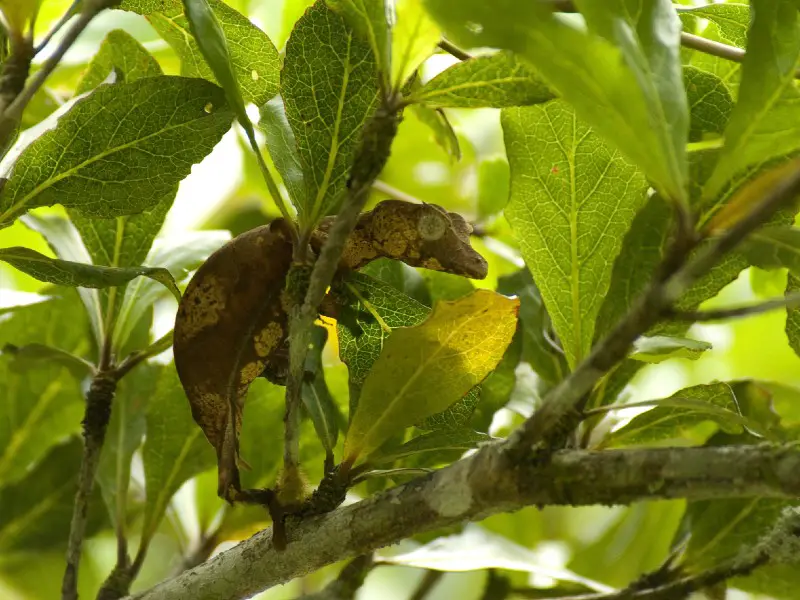
Since satanic leaf-tailed geckos are appropriate pets for advanced reptile caretakers, you will not normally find them available at your run-of-the-mill pet store. These geckos can be bought from specific breeders, and care should be taken to ensure that they have been bred in captivity, not collected illegally as wild animals.
You will usually find such breeders at exotic pet and reptile expositions and shows, or you can search for reptile hobbyists online. Beware of buying from just anyone online, though, as there are many false claims or illegal sales of wild-caught satanic leaf-tailed geckos circulating the Internet.
The average cost of a satanic leaf-tailed gecko can range from $300 to $500, depending on the breeder. These geckos are highly specialized and require a lot of specific expert care and, as such, are not inexpensive to purchase and own.
Facts and Useful Information
|
Species Facts |
|
|
Common Name |
Satanic Leaf-Tailed Gecko |
|
Species Name |
Uroplatus phantasticus |
|
Family Name |
Gecko |
|
Price |
From $300 to $800 |
|
Size |
Between 2.5 to 3.5 inches long |
|
Lifespan |
Up to 10-12 years |
|
Diet |
Land snails and other insects |
|
Tank Size |
They should live in a cage no smaller than 10 inches long, 10 inches wide, and 20 inches tall |
|
Humidity and Temperature |
72 and 78 degrees Fahrenheit and humidity at or superior to 65% |
|
Popular Alternatives |
Crested gecko |
Tank Setup
Satanic leaf-tailed geckos require adequate vertical space for climbing and fare well in tanks made of glass or clear plastic and equipped with a screen or ventilated cover. Your gecko’s tank should be at least ten inches wide, ten inches deep, and twenty inches high.
In the bottom of the tank, peat moss or sphagnum moss provide ideal substrates since they trap water droplets which allow your satanic leaf-tailed gecko to stay hydrated. Since this gecko species originates in the rainforests of Madagascar and spends the majority of its time hiding, lots of vegetation will make your gecko’s tank a suitable habitat.
Live plants such as bendy vine, bromeliads, ficus, dracaena, and golden pothos add variety to your gecko’s tank and allow for plenty of areas to hide and climb. Be sure to check that any plant you want to add to your pet’s enclosure is not toxic before you introduce it.
Temperatures should remain cooler and humidity high, as previously mentioned. Unlike most reptiles that require a basking light, satanic leaf-tailed geckos do not need one. Just be sure to keep them on a 12 hour light cycle so that they can carry out their nocturnal hunting and activities to keep healthy.
Average Size
Satanic leaf-tailed geckos are not large reptiles and will reach a maximum length of 2.5 to 3.5 inches in length, with males being slightly longer than females. Their maximum weight is barely measurable in English units, with males being lighter than females at 0.1 to 0.2 ounces (4 to 6 grams) compared to 0.3 ounces (8 to 9 grams), respectively.
Appearance
Satanic leaf-tailed geckos range in color from different shades of brown to orange to even purple. Their bodies mimic the appearance of dead leaves, especially the tails. In females, the tails resemble fresher leaves than those of males, which can be helpful when trying to tell the difference between the two sexes.
Their bodies are rough and jagged in appearance like leaves and bear thin vein-like markings to help camouflage them with the leaf litter of the floor of their rainforest homes.
Breeding Satanic Leaf Tailed Geckos
If you want to try your hand at caring for a breeding pair of satanic leaf-tailed geckos, you will need a slightly larger enclosure than necessary for a singular pet. A tank that is 12 inches wide, 16 inches deep, and 20 inches high should be sufficient to house a male and a female together.
While little is known about the natural breeding habits of satanic leaf-tailed geckos, scientists have surmised that they tend to spawn during the rainy season of their Madagascar island homes.
A few cues might suggest to you that your pair is ready for breeding, including particular motions of the tail that the female will signal to the male to fertilize her eggs. You will also be able to tell when a male is mature enough to mate because his tail will assume a bulbous nature while the females stays flat and leaf-like.
During breeding, males will usually employ a bite on the neck to secure the female and ensure she does not get away. In return, females will display short bursts of head-shaking until the male has finished.
It is best to lay down some leaf litter on top of the moss substrate in the bottom of the tank, as females have been known to deposit their eggs underneath the fallen leaves of the rainforest floor. The female satanic leaf-tailed gecko will lay two eggs at a time that incubate for about 60 to 70 days.
In the wild, a female can lay up to six clutches a year, so if you are really lucky, you may have a dozen baby satanic leaf-tailed geckos crawling up the sides of your tank before too long!
Summary

Satanic leaf-tailed geckos require expert care and attention and are not pets for amateur reptile hobbyists. They have a shy disposition and do not like to be handled. They prefer a habitat with lots of vegetation to climb and hide that supports high humidity and cool temperatures, mimicking their mountainous rainforest origins of Madagascar.
Satanic leaf-tailed geckos are active at night and prefer hunting their favorite insect or arachnid prey. However, supplemental vitamins should be added to their diet to ensure they obtain all the necessary nutrients to maintain their health and avoid disease. Light daily misting of their tanks is enough to ensure they will keep hydrated as they consume the droplets accumulated on the various surfaces of their enclosures.
These geckos do not pose a threat to humans, but care should be taken to ensure that purchase comes from vetted sources of captive-bred animals so as not to further the illegal trade of wild-caught ones. They can be expensive to purchase but rewarding to breed as a successful year of breeding may yield up to twelve young geckos.
Overall, this unique gecko, whose appearance resembles that of their leaf litter habitat, can be challenging to maintain but provide a satisfactory pet experience. Their exotic behaviors and personalities have the ability to be your constant companion for up to a decade as long as you ensure their proper health and maintenance.
References:
- https://en.wikipedia.org/wiki/Uroplatus_phantasticus
- https://www.nationalgeographic.org/projects/photo-ark/animal/uroplatus-phantasticus/

